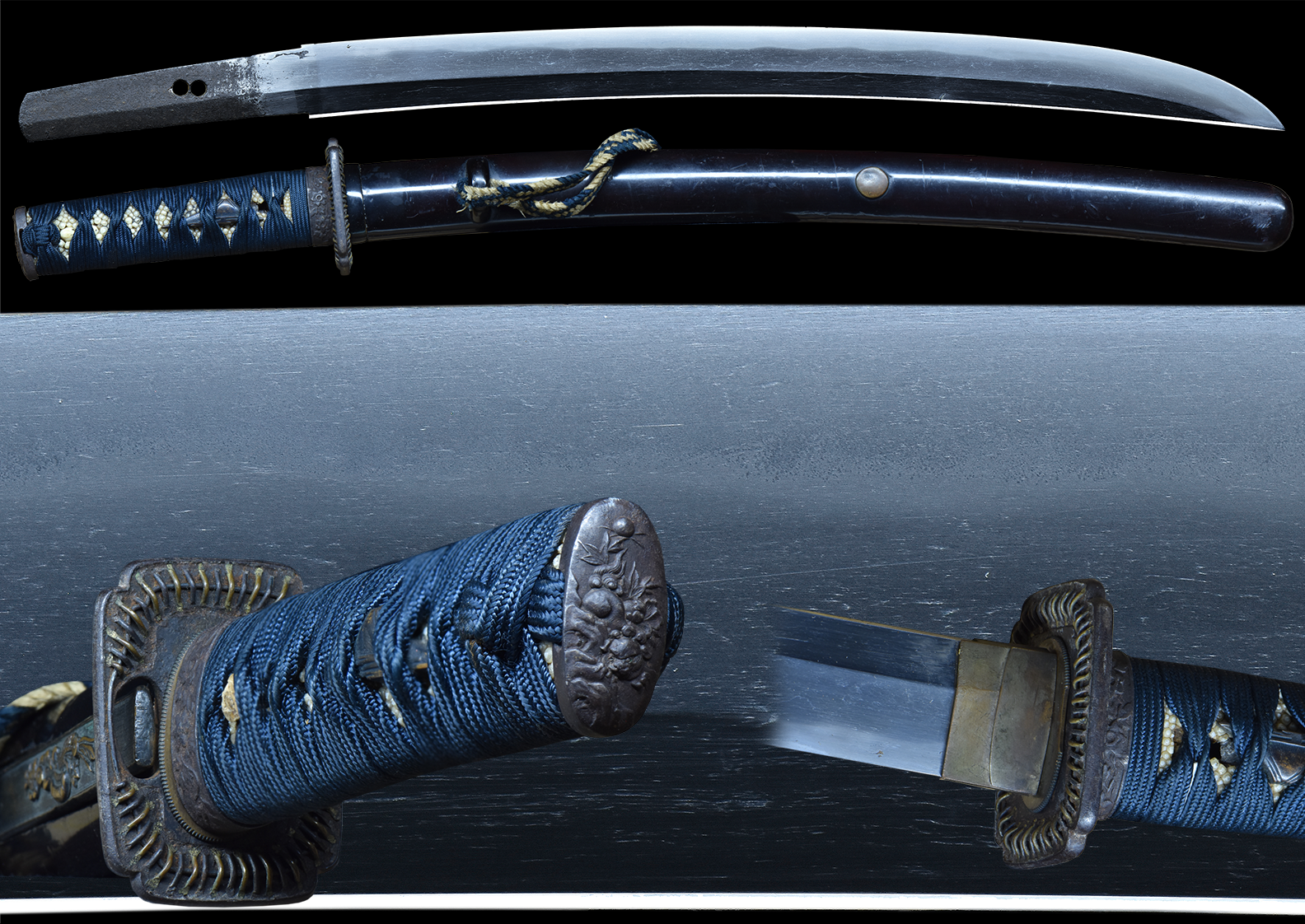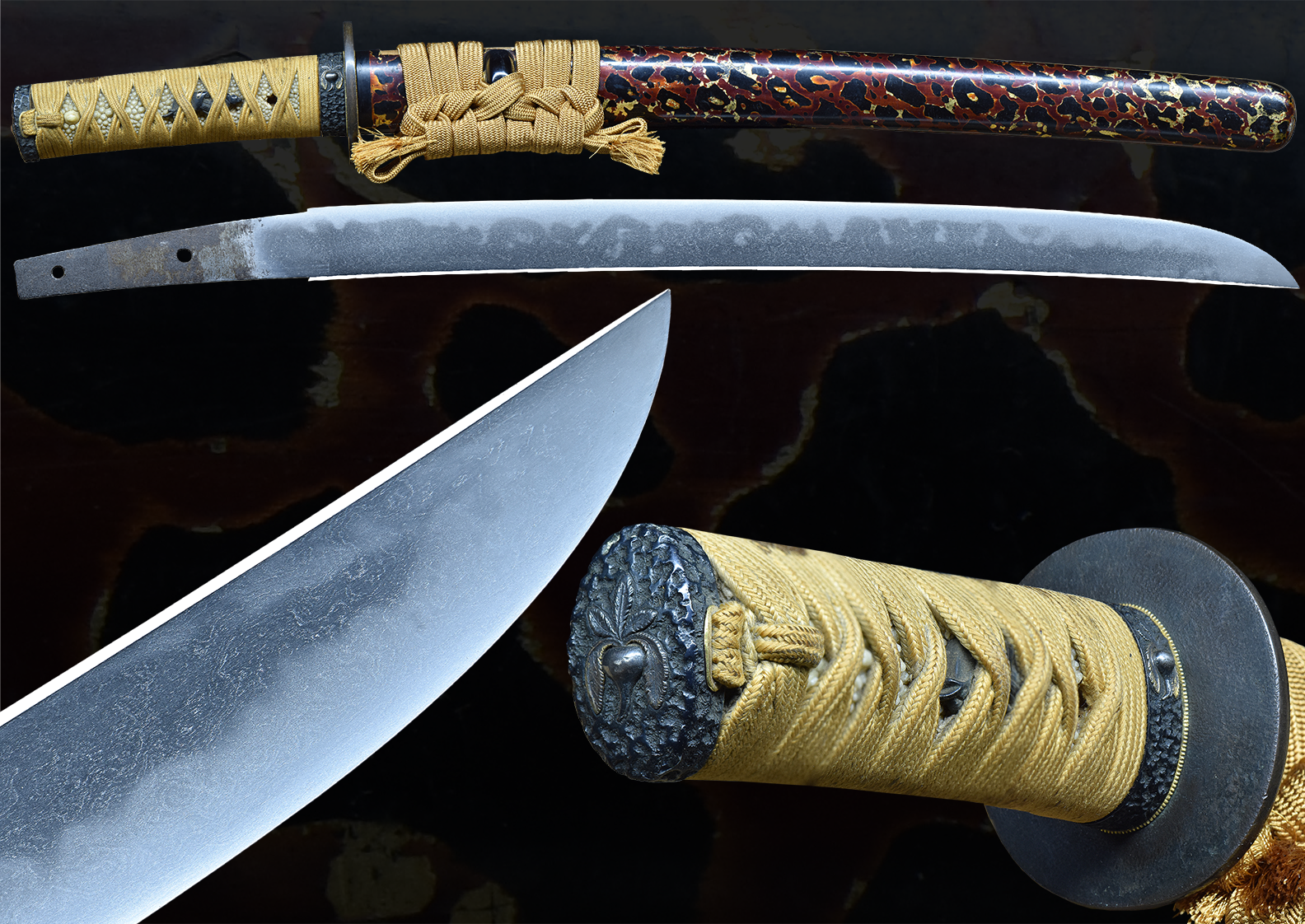We are pleased to be able to offer an extremely rare Nambokucho era Soshu Masahiro. This blade is loaded with hataraki and horimono as can be seen in the pictures. One side has a carving of a Dragon wrapped around a ken with vajra or ” Shin no Kurikara “. The other side has a Bonji representing “Fudo Myoo ” with Gomabashi and Rendai or lotus blossums”. There is sunagashi, kinsuji and chikei. Ji-nie also abounds. There is a unique 3 dimensional quality to the steel as if looking through a pool of water at the hataraki, rarely seen and can be found on the best of Soshu blades. A great sword for the connoisseur of the early Soshu school just a couple of generations from Masamune. His influence can be greatly felt in this piece.
This is a true Sunobi Tanto from the Nambokucho era, ubu with 3 holes. The sword is wide and beautiful to behold. A true Soshu masterpiece. It has Mitsumune and in an exquisite polish. This sword has very nice Nambokucho style horimono
The koshirae is ensuite with a myriad of Dragonflies as the motif:
“Dragonfly: According to legend, a passing soul
can take the shape of a dragonfly, especially during
Bon, the Buddhist Day of the Dead.”
The Fuchi/Kashira are in soft metal with the eyes made of Radon or mother of pearl and appear to glow!. Truly spectacular. The kodzuka is of 2 dragonfly of different type and butterfly and very old. The kodzuka blade is hand forged with kanji. The tsuba is of Iron Sukashi style of dragonfly motif and very old also. This may date to the momoyama period or older and a bit worn and narrow on one side. The menuki are of high quality and of Bees. The tsuka appears very old also with old Same and an original black silk tsuka ito. The kurikata and Kojiri stay with the dragonfly theme and a butterfly appears.
THERE IS SHIRASAYA ALSO FOR THE BLADE THOUGH NOT SHOWN IN THE PICTURES.
The Papers are Tokubetsu Hozon which attests to the authenticy and quality of the blade. The papers state late Nambokucho as the era. Below are the 2 generations of Masahiro from the late Nambokucho period.
MASAHIRO (正広), 2nd gen., Meitoku (明徳, 1390-1394), Sagami – “Sōshū-jū Masahiro” (相州住正広), “Masahiro” (正広), suguha-chō mixed with slightly undulating notare, gunome, ashi, yō, sunagashi and small tobiyaki in nie-deki, higher gunome elements towards the bōshi area can be connected to the kaeri and muneyaki
MASAHIRO (正広), 3rd gen., Ōei (応永, 1394-1428), Sagami – “Sagami no Kuni-jūnin Masahiro” (相模国住人正広), “Sōshū-jū Masahiro” (相州住正広),, “Sōshū-jūnin Masahiro” (相州住人正広), only few blades are extant by him, the jiba is no longer noticeably nie-laden with his generation
Usually with these lineages, the NBTHK does not go the extra mile and give a clear generation. They just say it it is most likely not the first generation who was active around heyday Nanbokucho (Joji 1362-1368). And also it isn’t one of the Muromachi smiths as otherwise they would have stated “Kodai Masahiro,” i.e. later generation Masahiro.
SOSHU Masahiro lived in Odawara and made a very active soshu style hamon very similar to Akihiro and Hiromitsu especially when producing hitatsura.
This Hamon is a very active and wonderful example of a soshu masahiro sunobi tanto. The blade has a beautiful polish and full of activity. Inside of the hamon, there is kinsuji, sunagashi, ji-nie and much more.
The sword is papered tokubetsu hozon and a wonderful sword.
The Habaki is a gold washed higo style.
The NBTHK papers date this to the late nambokucho era:
- Mei: Mumei
- Date: late Nanbokuchô period
- Nagasa: 13-1/2 inches
- Sori: 7.5. mm
- Width at the ha-machi: 30.8 mm
- Thickness at the mune-machi: 5.5 mm
- Construction: Shinogi zukuri
- Mune: Iori
- Nakago: Ubu
- Kitae: Itame
- Hamon: Midare Gunome
- Boshi: Maru
- Condition: Good polish
(shipping and insurance included)
Email us if your interested in this item and remember to include the order number for this item: fss-857.
Click to Enlarge Image
Click to Enlarge Image
kantei-sho (鑑定書) No 1005172 wakizashi, mumei: Sôshû Masahiro (相州正広) (Jidai Nanbokuchô kôki, 時代南北朝後期)
nagasa 1 shaku 1 sun 4 bu Migi wa tô-kyôkai ni oite shinsa no kekka, tokubetsu-hozon-tôken to kantei-shi kore o shô-suru.
(右は當協會に於て審査の結果特別保存刀剣と鑑定しこれを証する)
Heisei nijûhachinen sangatsu nijûsannichi (平成二十八年三月二十三日)
kôeki-zaidan-hôjin (公益財團法人): Nihon Bijutsu Tôken Hozon Kyôkai (日本美術刀劍保存協會)
Appraisal
wakizashi, unsigned: Sôshû Masahiro (late Nanbokuchô period)
nagasa ~ 34.5 cm According to the result of the shinsa committee of our society we judged this work as authentic and designate
it as tokubetsu-hozon-tôken. March 23rd 2016
[Foundation] NBTHK
For Sale

























